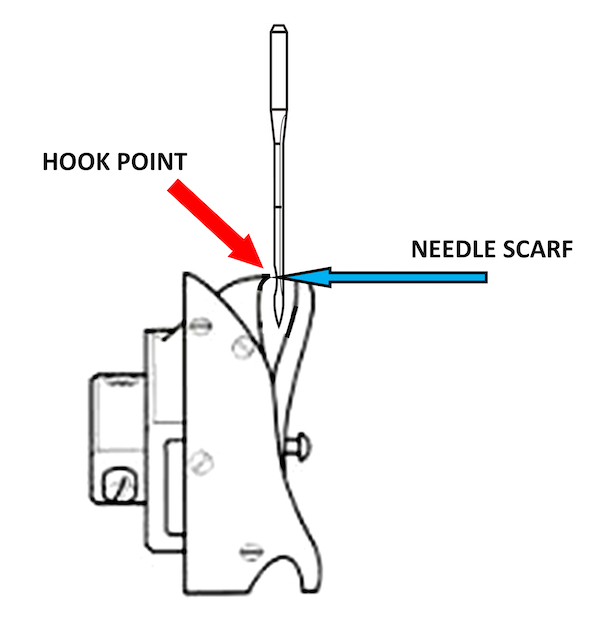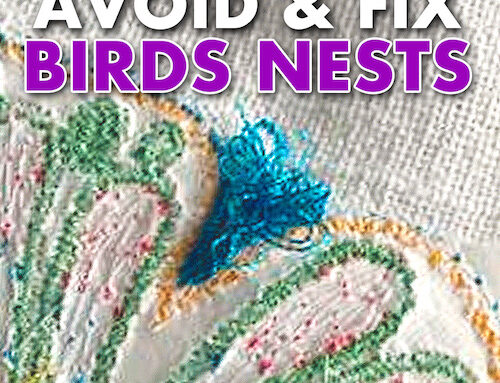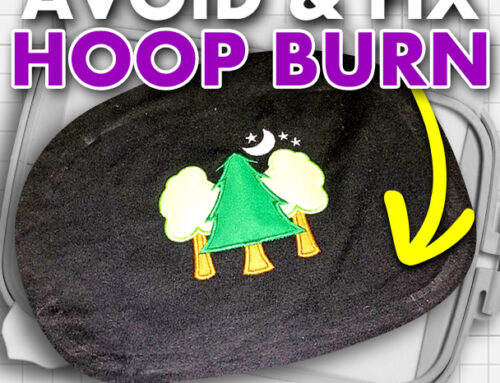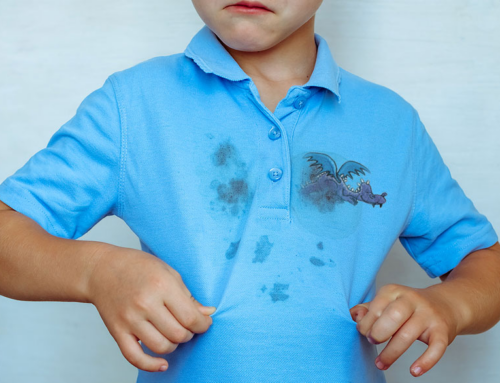When that embroidery machine arrived at your door, and the tech started it up for the first time, did you stand there and marvel at all the engineering and technology that must have gone into the precise timing involved in creating stitches at such high speeds?

Amazingly, one of the primary functions that make it run so smoothly is that with each revolution the machine makes, the tiny needle that carries the top thread needs to precisely interact with the rotary hook on the bobbin casing, creating a perfect loop as the two pass each other.
The truly amazing thing is that this happens while the machine runs at speeds of 700 to 1200 stitches per minute!
If you take the time to look closely at a needle, you soon realize the incredible amount of engineering that has gone into a disposable item that is changed so frequently. The needle itself is made up of many components that are shown below:

Notice that the front and back of the needle are very different and need to be placed in the machine with a fair bit of care and accuracy.
If you’re placing a new needle on the machine and you don’t line up the “eye” of the needle, so it’s perfectly straight, you will change the distance of where the “scarf” (back of the needle) meets the rotary hook, and it will greatly affect the performance of the machine. I know this should fall into the “common sense” category. Still, I can’t tell you how many times when I was running contract embroidery, that my seemingly experienced operators would make this mistake and then wonder why that head wasn’t embroidering well.
Another simple mistake I saw repeatedly was that the “butt of the shank” wasn’t pushed up into the machine, which again changes the distance of the “scarf and hook timing.”
Be sure to read to keep reading as we answer your most commonly asked questions about everything embroidery needles!
Needles For Machine Embroidery
If we get right down to the basics, the smaller the needle, the more detailed the design with less penetration to the fabric, causing weakening. The larger the needle, the heavier/denser the fabric, producing larger holes.
Thinner thread = smaller needle
Thicker thread = larger needle
Pretty easy, right? Needles come in sizes ranging from 60/8 to 110/18; the larger the number, the larger the needle, with 75/11 or 80/12 usually the most standard size.
Looking at all the codes and system numbers for needles can quickly become confusing. The basic idea is that the numbers refer to the length of the needle, the eye size and location, and the eye-to-tip distance.
The needle below is an example of the dimension and shape of a DbxK5 needle.
The best rule of thumb is to ask your machine manufacturer the best needle to use for most general applications on your machine.

I ran a contract embroidery facility for over 15 years with over 135 heads, 99 percent of the time, we used a 75/11 sharp point needle.
Changing needles for that “difficult” job once in a blue moon was necessary, but I never went overboard, trying not to cause a great deal of confusion and unneeded downtime in production.
For the most part, we wouldn’t even change our needles if we were running on leather; I would instead make sure the design was modified at the digitizing stage, creating a file with less underlay and density before it got to production. Time is money, and if you’re changing needles for 3-4 colors on 24 heads, that equates to excessive downtime!
If you are a shop that uses varying thread sizes, you’ll probably want to try and use a needle with a larger “eye” size to accommodate them, but in my experience, keeping it as simple as possible is a much better way to go.
What Needle Should I Use For My Embroidery Machine & Fabrics?
At this point, I’m sure I have a lot of people adamantly disagreeing with me! Changing your needles for varying applications is how it should be done, but it will give you a lot more to consider.
The first thing a lot of you must have thought was, “he used a sharp point needle for everything? Aren’t they just supposed to be used on woven materials?” Using a ball point or universal needles is much better for specific applications and absolutely necessary for others if we get technical.

Ball point needle pictured above
A ball point needle will push aside the fabric rather than puncture through it and prevent damage on knit goods; if you do very intricate work on fine satins, let’s say geared to the lingerie industry, you’ll need to switch to ballpoint. Then within the “ball point” family, you can choose light ballpoint, medium ballpoint, special ball point, and heavy ballpoint. Varying for fabrics from lightweight knits and satins to extremely bulky sweaters and everything in between.

Leather needle pictured above
If you are trying to run your designs on leather without modifying them, you’ll probably need to switch to a “narrow wedge point” needle. The idea behind this needle is that as it perforates the leather, it leaves enough distance between the stitches in the embroidery to maintain the strength of the leather. You might be able to punch out the design after embroidering if you don’t.
Interested in learning more about embroidering on leather and vinyl? Check out our guide to teach you why problems arise and some tips, tricks, and best practices to get better-embroidered results by clicking here.

Notice the difference between a set (sharp) point needle (recommended for knit goods) & a narrow wedge point needle (recommended for leather)
If you’re having trouble running metallic threads, switching to a needle with a larger eye or a needle particularly designed with an eye-shaped like a rectangle will aid the passage of the thread through the needle’s eye.
Are you struggling with thread breaks on your embroidery machine when using metallic or polyester thread? Check out our article on how to prevent metallic threads from breaking by clicking here. Plus, we may even show you a hack to create your own DIY spool holder!
Again, I cheated and kept my thread saturated in silicone rather than going through changing needles.
Specialty Embroidery Needles
Various manufacturers offer needles with different coatings that make them unique. Single-head machines will run considerably faster than their multi-head counterparts. A machine running at 1200 stitches per minute will create heat and friction that can cause synthetic threads to break and melt holes through some types of synthetic fabrics.
Standard needles are chromium-plated, and as they heat up, synthetic material may stick to the needle. Teflon TM coated, and “Cool-Sew” finishes on these needles help alleviate the sticking and heat-buildup problems.

Non stick needle pictured above
Needles with a titanium-nitride ceramic finish make them more wear-resistant, extending the life of the needle 3-5 times longer, and can also be helpful when trying to embroider through very tough fabrics. They maintain their needlepoints longer and maintain overall strength with a reduced deflection at high speeds.
Machine Embroidery Needle Life
It’s said that the average needle life is approximately 2 million stitches.
If we try and break it down to just how long that is, it might look something like this:
Speed 650 stitches/m
=39,000 stitches/hr
@ 100% run time= 312,000 stitches/day
@ 80% run time= 265,200 stitches/day
2,000,000 / 265,200 = 7.5 days
Now that’s a nice little equation on paper, but try and keep track of it if you have an 18-head machine with 9 needles… that’s 162 needles to keep track of! We had a simpler strategy in production; if it isn’t broke, don’t fix it! An experienced operator can tell by the visual look of the embroidery and the machine’s performance if a needle life has expired.
Skipped Stitches?
Skipped stitches can generally occur if the needle groove and size of the eye are not appropriate for the thread’s size or characteristics. Improper rotary hook timing can also cause this effect. It’s much easier for the operator to first solve the problem by checking the needle than it is to start right away messing with the rotary hook timing.

Caution with Embroidery Needles
Above all else, maintain a healthy respect for that little piece of metal. Operators tend to get a little cocky as time passes by…thinking their ability to clean stray threads while the machine is running is a measure of their experience.
Over the years, I’ve taken my fair share of employees to the emergency room. I used to try and lighten things up by saying, “you’re not a true embroiderer till you’ve gotten a needle through your finger.”
I’ve had it happen twice, so I don’t know if that makes me a really good embroiderer or just stupid! The second time it happened, I hit a bone. Did you know that the needles shatter into many pieces when that happens? The funny thing is it happened the day my eldest son was born. I was downstairs having my finger dissected while mom was upstairs in labor; meanwhile, the staff kept us both updated with each other’s progress. I did make it to the delivery room with time to spare, and it’s not hard to forget the last time I put a needle through my finger. I highly do not recommend it!
Answers to Your Common Embroidery Machine Needle Questions
We have had many needle questions lately in our Machine Embroidery & Digitizing Made Easy Facebook Group. So to help you out, I decided to take some time to supplement this article with the answers!
What Are The Different Types of Embroidery Machine Needles?
First off, machine embroidery needles are not the same as sewing machine ones though they may look identical. The eye on a machine embroidery needle is larger, allowing the thread to pass through and not cause a drag on the thread, which can fray it. There are two basic types of needles:
- Round Point or Sharp needle: This is the most common needle. It has a sharp point is which is suitable for most fabric types. These needles can be used in embroidery machines.

- Ball Point: Ball points are not as sharp as a round point (but they still hurt if you run one into your finger!!). They are designed to go in between fibers as it pierces and not cut them. These work well on slinky materials, knits, performance wear, and other fabrics which are manmade and have many, many microscopic fibers in each strand of thread or yarn.

Embroidery needles are most commonly the ones above. Still, they can have added features such as titanium coating, making for a more durable needle or a needle with a “non-stick” coating for working on rubber or other more tacky materials
What Is A Needle System?
Use a recommended “system” to ensure you have the right needle for your embroidery machine. Think of it as a cartridge in a printer. Brand A always uses this system (shape or type of cartridges), and brand B uses another system.
Your dealer or owner’s manual will advise you on the system for your machine, and you will then be able to select your perfect needle. The shape of the needle shank determines the system; some are round, some flat. For example, a home sewing machine uses a flat shank, System 130 needle.
How Do I Read A Needle Pack?
Like all things, needle packs have their own language, and once you learn it, you will understand what you are seeing.
The needle pack will tell you the needle type (embroidery, universal, denim etc.), the size, and the system. We won’t get into how system names came about, but the needle size that looks confusing is not.
These numbers can range from 65/9 up to 100/16. For example, 75/11 is the same size expressed in 2 ways! 75 is the European size in mm (.75mm in diameter), and the 11 is the US standard size. The larger the numbers, the heavier the needle.
Oh Drat! The needle is not in the pack! Have no fear! The size and system of the needle are stamped on the needle, and after you secure a magnifying glass, you will be back in business.

How Do I Store Embroidery Needles?
Like anything metal, needles like to be stored in a dry, cool place where they will not be disturbed. If possible, please keep them in their packs so you know what type they are and so the tips, eyes, or shanks are not damaged.
While it is a good idea to sort currently used needles that are not in the machine on a divided board, pin cushion or other surfaces you stab into- remember that penetrating a rough or tough surface will damage your needle. They are best stored in small sandwich bags or bottles labeled with the type and size. You can add a cotton ball in the bottom to secure them, so they do not roll about.
How To Clean Embroidery Needles
Do embroidery needles get dirty? Absolutely! Remember that wonderful sticky spray you used to tack down that last project? Well, microscopic bits of that tacky goo can become lodged in the eye, stuck on the shank, or gathered at the top of the needle and must be cleared away. Use rubbing alcohol (remember your gloves in a well-ventilated room!) and wipe them clean.
How Can I Tell If My Embroidery Needle Is Dull
Many embroiderers can hear the machine begin to pound as the needles get dull but here are some signs you need to change out needles:
- Shredding thread
- Puckering fabric or pulling threads
- Skipped stitches or uneven stitches
- Needle not able to stitch through dense material and hitting needle plate
If you have a 6 needle or less machine, it is not a tremendous expense, but many people change out all needles at the same time. For those with 15 needle machines, it can be more. Many people change out the black and white needles as those are often used the most. A reasonable practice would be to keep a notepad with dates you change needles and try to stay around the 2 million stitch mark noted above.
Why Do My Embroidery Machine Needles Keep Breaking?
Needle breakage can come from many sources, but here are some of the top ones:
Poor quality needles. Yes, there are luxury brand needles and bargain-basement varieties, but this is a simple rule of thumb: plan to use the most expensive needle you can afford. In the end, they are not that expensive, and ruining a garment or damaging a machine from trying to save a little bit is not worth it.
Dull needles. See the discussion above about changing needles; as they get duller, they will not work in dense embroideries and can break.
Nesting. All of us have seen a bird’s nest from time to time, but often you don’t see the hidden damage. A bird’s nest can bend or break a needle while it gathers. Make sure your machine is clean and threaded properly.
Flagging. Sounds great in a parade but walking by and seeing a hoop waving at you while stitching should set off alarm bells! Flagging is the material being pulled up and pushed down by the needle and thread loop, and the vibration of the hoop is started. Too large a hoop can cause a banging hoop for the project and the material bounces, floating material, machine maintenance etc.
While it is tempting to buy every type of needle offered for your machine- a reasonable practice would be to use 75/11 round or ball point, and after you get to know your embroidery machine and the fabrics you will use, invest in more specialized needle types.
Conclusion: Choose The Right Needles For Your Machine Embroidery
With all this information and diagrams we’ve gone over, it appears there is more to a needle than just the appearance of being a small sharp metal stick.
It’s best to know when to change your needles to avoid losing money if you’re doing big production projects or knowing when to change your needles on your home machine based on the embroidery or fabric you’re using.
Get The Most Out Of Your Needles By Using Quality Embroidery Designs
Use and apply your new knowledge to your next embroidery project! You can start by clicking here to download our Free Embroidery Legacy Design Kit, where we give you 11 fan-favorite designs, or check out our database of close to 30,000 quality machine embroidery designs.
Remember, have fun & watch your fingers!






Such valueble information and tips. Thank you so much!!
Glad you enjoyed it! You’re most welcome 🙂
On reading this I was hoping to find out what machine embroidery needle to use when stitching Mylar. My design tore away from the satin stitching.Your article was most interesting. Thankyou
Hi Marilyn, our pleasure.
I’d recommend you ask your machine manufacturer which is the best needle to use for Mylar. I haven’t experienced that issue before nor do I know which machine you’re using so I’d hate to steer you wrong. I’m curious too though, please keep me posted what you find out.
– Jesse
Hi Sir,
I am facing a problem with navy color thread text 27 in off white fabric. It is too loose, we increased stitch count but still look like spacing and not getting thickness. The stitch count other color thread, black color thread in navy knit fabric looks more thick which buyer pass. Why this difference comings in same stitch count.
Hi Manoharan, I’m not sure why that would be happening? Have you tried a different brand of thread?
Love the cup/pencil idea for metallic thread. Where/how do you position the cup on the machine?
I have a Brother Stellaire machine.
Hi J, I would just place it beside the machine not on it.
Very helpful. Thank you.
Thanks for reading 🙂